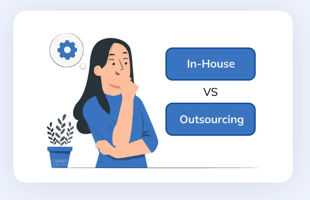In today's fast-paced business environment, outsourcing has become a common practice for companies...
Outsourcing vs Outstaffing: Choosing the Right Business Model
Introduction
In the modern business landscape, optimizing operations and resource allocation is essential for sustainable growth. Two prominent strategies that companies often turn to are outsourcing and outstaffing. While these terms might sound similar, they represent distinct approaches to resource management. This article delves into the nuances of outsourcing vs outstaffing, highlighting their key differences, benefits, and potential drawbacks.
Outsourcing vs Outstaffing: A Closer Look
Understanding the fundamental differences between outsourcing and outstaffing is crucial for making informed business decisions. Let's explore these two concepts in detail:
Outsourcing: Delegating Projects and Tasks
Outsourcing involves contracting external parties, often third-party companies or freelancers, to handle specific projects, tasks, or functions. This approach allows businesses to tap into specialized skills without the need to hire full-time employees. Outsourcing can encompass various aspects, including software development, customer service, and digital marketing.
Outstaffing: Extending Your Team
Outstaffing, on the other hand, entails hiring dedicated remote employees through a staffing agency. These employees work exclusively for your company, even though they are technically employed by the agency. This model provides a more integrated and long-term solution, as outstaffed employees become an extension of your in-house team.
Outsourcing vs Outstaffing: Pros and Cons
Both outsourcing and outstaffing offer unique advantages and come with their own set of challenges. Let's break down the pros and cons of each approach:
Outsourcing Pros:
- Access to specialized expertise.
- Cost-effective for short-term projects.
- Scalability and flexibility in resource allocation.
- Reduced administrative overhead.
- Opportunity to focus on core business functions.
Outsourcing Cons:
- Communication challenges with external teams.
- Limited control over project timelines.
- Potential security risks in sharing sensitive data.
- Quality inconsistencies among different vendors.
Outstaffing Pros:
- Dedicated resources committed to your company.
- Greater control over project management.
- Long-term collaboration and team integration.
- Seamless communication within the extended team.
- Potential for lower costs compared to hiring full-time employees.
Outstaffing Cons:
- Slightly higher costs than traditional outsourcing.
- Management complexity due to remote team coordination.
- Potential language and time zone barriers.
Making the Choice: When to Outsource and When to Outstaff
Knowing when to opt for outsourcing or outstaffing depends on your business's specific needs and goals. Consider the following scenarios:
Choose Outsourcing When:
- You require specialized skills for a short-term project.
- Cost efficiency is a primary concern.
- You want to streamline non-core functions.
- Quick scalability is essential for your project.
Choose Outstaffing When:
- Long-term collaboration and team integration are vital.
- You need dedicated resources for ongoing projects.
- Project management control is a priority.
- You seek a balance between in-house and remote teams.
FAQs
What's the main difference between outsourcing and outstaffing?
Outsourcing involves hiring external parties for specific tasks, while outstaffing entails hiring remote employees as part of your team through a staffing agency.
Can I maintain control over a project while outsourcing?
Yes, but it requires clear communication and well-defined project scopes to ensure your expectations are met.
Is outstaffing more expensive than traditional outsourcing?
Outstaffing might have slightly higher costs due to the dedicated nature of the arrangement, but it can still be cost-effective compared to hiring full-time employees.
How do I manage time zone differences in an outstaffing model?
Effective communication tools and scheduling adjustments can help bridge the gap and ensure smooth collaboration among teams in different time zones.
Can I switch from outsourcing to outstaffing or vice versa?
Yes, many businesses transition between these models based on their evolving needs. Flexibility is a key advantage of both approaches.
Are there security risks associated with outsourcing?
While outsourcing can involve sharing sensitive information with external parties, choosing reputable vendors and implementing security measures can mitigate potential risks.
Conclusion
In the dynamic landscape of business operations, choosing between outsourcing and outstaffing involves assessing your company's immediate and long-term requirements. Outsourcing offers flexibility and specialized skills for short-term projects, while outstaffing provides dedicated resources and long-term collaboration. By understanding the nuances of each model, you can make an informed decision that aligns with your business goals, ultimately driving growth and success.


